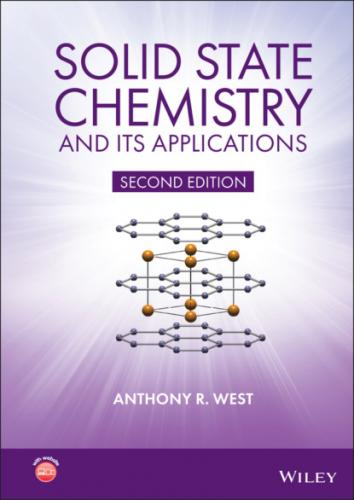a These formulae do not necessarily apply when c/a is different from the ideal value of 1.633.
1.17.3 Wurtzite (ZnS) and nickel arsenide (NiAs)
These structures have in common an hcp arrangement of anions and differ only in the positions of the cations, as follows:
wurtzite: T+ (or T–) sites occupied; T– (or T+), O empty
nickel arsenide: O sites occupied; T+, T– empty.
These structures are the hcp analogues of the ccp sphalerite and rock salt structures, respectively. Note that there is no hexagonal equivalent of the fluorite and antifluorite structures.
Both wurtzite and nickel arsenide have hexagonal symmetry and unit cells. A unit cell containing hcp anions is shown in Fig. 1.35(a). It is less easy to visualise and draw on paper than a cubic cell because of the γ angle of 120°. The unit cell contains two anions, one at the origin and one inside the cell:
In Fig. 1.35(b) is shown a projection down c of the same structure. Close packed layers occur in the basal plane, i.e. at c = 0 (blue circles), at c = 1 (not shown) and at
Figure 1.35 The wurtzite and nickel arsenide structures: (a–c) the hexagonal unit cell of an hcp anion array; (d, e) interstitial sites in an hcp array; (f, g) structures of wurtzite and NiAs; (h, i) trigonal prismatic coordination of arsenic in NiAs; (j–l) models of the ZnS and NiAs structures showing the arrangement and linkages of the polyhedra.
In metals which have hcp structures, adjacent metal atoms are in contact, e.g. along a 1 and a 2 (≡b) edges of the unit cell (b, c). In eutactic cp ionic structures, however, the anions may be pushed apart by the cations in the interstitial sites. Assuming for the moment that the anions are in contact, then the hexagonal unit cell has a definite shape given by the ratio c/a = 1.633. This is because a is equal to the shortest distance X–X, i.e. the diameter of an anion, and c is equal to twice the vertical height of a tetrahedron comprising four anions. The ratio c/a may then be calculated by geometry (see Appendix C).
The interstitial sites available for cations in an hcp anion array are shown in Fig. 1.35(d) for the bottom half of the unit cell between c = 0 and
A detailed description of the sites that are occupied in wurtzite and NiAs is now given for completeness; such a degree of detail may, however, not be necessary to gain an overview of these two structures and is not compulsory reading! In Fig. 1.35(d), a T– site occurs along the c edge of the cell at height
Table 1.12 Some compounds with the wurtzite structure
| Compound |
|
|
u | c/a | Compound |
|
|
u | c/a |
|---|---|---|---|---|---|---|---|---|---|
| ZnO | 3.2495 | 5.2069 | 0.345 | 1.602 | AgI | 4.580 | 7.494 | 1.636 | |
| ZnS | 3.811 | 6.234 | 1.636 | AlN | 3.111 | 4.978 | 0.385 | 1.600 | |
| ZnSe | 3.98 | 6.53 |
|
